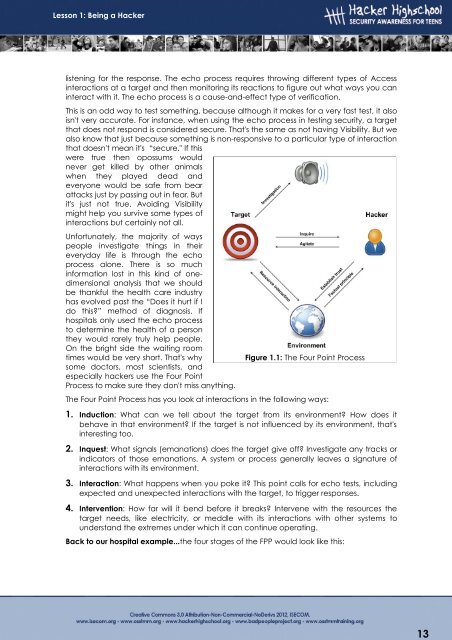Lesson 1: Being a Hacker - Hacker Highschool
Lesson 1: Being a Hacker - Hacker Highschool
Lesson 1: Being a Hacker - Hacker Highschool
You also want an ePaper? Increase the reach of your titles
YUMPU automatically turns print PDFs into web optimized ePapers that Google loves.
13<br />
<strong>Lesson</strong> 1: <strong>Being</strong> a <strong>Hacker</strong><br />
listening for the response. The echo process requires throwing different types of Access<br />
interactions at a target and then monitoring its reactions to figure out what ways you can<br />
interact with it. The echo process is a cause-and-effect type of verification.<br />
This is an odd way to test something, because although it makes for a very fast test, it also<br />
isn't very accurate. For instance, when using the echo process in testing security, a target<br />
that does not respond is considered secure. That's the same as not having Visibility. But we<br />
also know that just because something is non-responsive to a particular type of interaction<br />
that doesn't mean it's “secure." If this<br />
were true then opossums would<br />
never get killed by other animals<br />
when they played dead and<br />
everyone would be safe from bear<br />
attacks just by passing out in fear. But<br />
it's just not true. Avoiding Visibility<br />
might help you survive some types of<br />
interactions but certainly not all.<br />
Unfortunately, the majority of ways<br />
people investigate things in their<br />
everyday life is through the echo<br />
process alone. There is so much<br />
information lost in this kind of onedimensional<br />
analysis that we should<br />
be thankful the health care industry<br />
has evolved past the “Does it hurt if I<br />
do this?” method of diagnosis. If<br />
hospitals only used the echo process<br />
to determine the health of a person<br />
they would rarely truly help people.<br />
On the bright side the waiting room<br />
times would be very short. That's why<br />
some doctors, most scientists, and<br />
especially hackers use the Four Point<br />
Process to make sure they don't miss anything.<br />
Figure 1.1: The Four Point Process<br />
The Four Point Process has you look at interactions in the following ways:<br />
1. Induction: What can we tell about the target from its environment? How does it<br />
behave in that environment? If the target is not influenced by its environment, that's<br />
interesting too.<br />
2. Inquest: What signals (emanations) does the target give off? Investigate any tracks or<br />
indicators of those emanations. A system or process generally leaves a signature of<br />
interactions with its environment.<br />
3. Interaction: What happens when you poke it? This point calls for echo tests, including<br />
expected and unexpected interactions with the target, to trigger responses.<br />
4. Intervention: How far will it bend before it breaks? Intervene with the resources the<br />
target needs, like electricity, or meddle with its interactions with other systems to<br />
understand the extremes under which it can continue operating.<br />
Back to our hospital example...the four stages of the FPP would look like this:

















